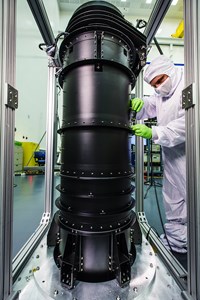Apr 16 2015
Northrop Grumman Corporation reached another major milestone for NASA's James Webb Space Telescope this week, with the delivery of the Deployable Tower Assembly (DTA). Following successful ambient and thermal vacuum testing, the DTA was delivered to Northrop Grumman's Space Park facility, where the Webb Telescope is being assembled. The graphite DTA was designed, built and tested by Astro Aerospace, a Northrop Grumman company.
 The Deployable Tower Assembly (DTA) for NASA's James Webb Space Telescope was delivered to Northrop Grumman's Space Park facilities in Redondo Beach, California for integration and testing. The DTA interfaces and supports the spacecraft and the telescope structures.
The Deployable Tower Assembly (DTA) for NASA's James Webb Space Telescope was delivered to Northrop Grumman's Space Park facilities in Redondo Beach, California for integration and testing. The DTA interfaces and supports the spacecraft and the telescope structures.
NASA's James Webb Space Telescope is made up of four major components — the telescope, the integrated science instrument module, the sunshield and the spacecraft. The DTA interfaces and supports the spacecraft and the telescope structures, and serves two key functions on Webb.
"First, in the stowed configuration, the DTA allows the telescope and instruments to fit into the rocket fairing with an acceptable center of gravity for launch. Second, in the deployed configuration, it will lift the telescope mirrors and instruments away from the heat of the main spacecraft. This allows the sunshield to unfurl, reducing the amount of radiant heat the instruments are exposed to on orbit," said Ken Aiello, Astro Aerospace cost account manager for Webb and program manager of the DTA.
Webb's DTA features two large diameter telescoping tubes, separated by a mechanized lead screw. The majority of the DTA is constructed of graphite components to ensure stability and strength with extreme changes in cryogenic temperature. When fully deployed, the DTA reaches ten feet in length.
"The Astro DTA team expertly completed this complex project, which required a deployable structure that is both very light and extremely strong and stable," said Scott Texter, Webb optical telescope element manager, Northrop Grumman.
The James Webb Space Telescope is the world's next-generation space observatory and successor to the Hubble Space Telescope. The most powerful space telescope ever built, the Webb Telescope will observe the most distant objects in the universe, provide images of the first galaxies formed and see unexplored planets around distant stars. The Webb Telescope is a joint project of NASA, the European Space Agency and the Canadian Space Agency. Northrop Grumman is under contract to NASA's Goddard Space Flight Center in Greenbelt, Maryland, for the design and development of the Webb Telescope's optics, sunshield and spacecraft. For more information, visit www.jwst.nasa.gov.
Since 1958, Astro Aerospace (www.northropgrumman.com/astro) has helped enable complex missions to Earth orbit, Mars and beyond with its innovative deployable space structures and mechanisms. The business unit's products have been successfully deployed on hundreds of space flights with a 100 percent success rate, a testament to Northrop Grumman's commitment to reliability, quality and affordability.
Northrop Grumman is a leading global security company providing innovative systems, products and solutions in unmanned systems, cyber, C4ISR, and logistics and modernization to government and commercial customers worldwide. Please visit www.northropgrumman.com for more information.
Source: http://www.northropgrumman.com/